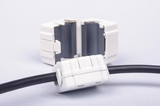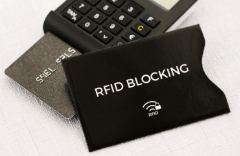Home » Sealing Products » EMI & RFI Shielding
EMI/RFI Shielding

EMI and RFI shielding are used to prevent radio and electromagnetic waves interfering with the essential functions of a variety of equipment from MRI and other medical devices to telecommunications, aerospace and automotive applications.
Custom Gaskets and Shielding for EMI
EMI shielding protects against electrostatic disturbances. Electromagnetic interference produces changing voltages and electrical currents that can come from both natural sources, such as lightning and solar flares, as well as manufactured sources, such as laptop computers and power lines.

Reducing the electromagnetic field in or around a space is a critical design factor for devices in nearly every field today, especially in industrial machinery, broadcast and other telecommunications, transportation, and medical/laboratory fields. Without adequate protection, the electrical noise from EMI -- and its subset RFI (radio frequency interference) -- can interrupt or crash an electrical circuit, leading to equipment failure that often has serious health, safety, public welfare, or financial consequences.
Protecting Against EMI/RFI
EMI/RFI is a major design factor in manufacturing products that rely on electronic circuitry. All electronic devices radiate a certain amount of electromagnetic radiation. The tolerance of equipment to RFI depends largely on how well it is designed. Poor enclosure design can significantly contribute to EMI/RFI. One way to contain this electronic noise is to use adequate EMI/RFI shielding that prevents incoming emissions and protect vital circuit boards methods of reducing EMI/RFI. Another is to provide sufficient EMI/RFI filtering to eliminate radiated electronic noise at the source as well as to prevent incoming emissions and protect vital circuit boards.

Most countries have legal mandates that determine a product’s electromagnetic compatibility, ensuring that hardware must function properly when subjected to certain amounts of EMI, while limiting the amount of EMI that the product can emit in order to not interfere with other equipment.
EMI shielding material reflects or absorbs the energy level of the electromagnetic field radiating into the desired protected area.
Selecting EMI/RFI Gaskets and Shielding
Web Seal can help you determine the type and thickness of EMI or RFI gaskets or other shielding for your particular application, considering usage, installation and other environmental factors such as:


- the volume of space requiring protection
- apertures in the design
- the level of frequency involved
- requirements for water sealing
- compression requirements
EMI seals and gaskets are constructed from a wide range of elastomers, foam, foil, wire mesh, fabric and metal combinations. EMI seals and gaskets can be extruded, spliced, molded and die-cut.
Web Seal can provide a variety of EMI and RFI shielding options, including:
- Standard conductive rubber shielding
- Composite gasket materials (silicone or fluorosilicone elastomers)
- Conductive felt gasket materials
- Connector gaskets
- Highly conductive metallized fabric-covered foam gasketing
- Frame and panel gaskets
- Shielding membranes
 EMI shielding materials block electrical interference with barriers of conductive or magnetic materials, isolating the electrical devices from the environment around them.
EMI shielding materials block electrical interference with barriers of conductive or magnetic materials, isolating the electrical devices from the environment around them.
EMI sealing is most commonly used in applications such as aerospace and automotive components, wireless networks and devices, electrical circuits and enclosures, shielded cables, electrical switching rooms, microwave ovens, medical scanning devices, security systems, and military operations.
Radio Frequency Interference (RFI) is when radio signals from one device affect the signals from another, causing adjacent electronic or electrical devices nearby to malfunction. RFI refers specifically to electromagnetic interference within the frequency range dedicated to radio transmissions, mostly several KHZ to 30 MHZ.
RFI has been instigating product and service disruption since the early development of radio and telegraph lines but rapid advancements in technology make adequate RFI shielding more critical than ever.
Computers, mobile devices and Bluetooth-enabled items are obvious sources of EMI/RFI. But everyday devices that are often overlooked and can also be potential sources of EMI/RFI include: driveway intercoms, doorbell transformers, electric blankets, electric bug zappers, heating pads, landscape lighting, outdoor loudspeaker lines, motion sensors, toaster ovens, touch-controlled lamps, and ultrasonic pest control devices. Less common sources involve an electrical spark, such as electrical welders, relays and switches, malfunctioning fluorescent or neon lighting, and vehicle spark plugs.
Common sources of RFI include transmitters of AM, FM and TV broadcast signals as well as ham radios, shortwave radios, CB radios, remote controls, cell and wireless phones, commercial aircraft, dispatch radios for police, taxis and ride-sharing services, radar systems, and untold medical and industrial RF devices.
A resource for EMI and RFI shielding and with many links to more specific articles can be found in this Electromagnetic Shielding article.
 RFID technology is everywhere. RFID chips are embedded in all types of applications we encounter daily:
RFID technology is everywhere. RFID chips are embedded in all types of applications we encounter daily:
- payment systems for public transport and tolls
- automatic identification via ID cards and passports
- asset management through inventory tracking, merchandise tags, and use of consumables
- logistics tracking, such as vehicle location systems and product traceability
- agricultural tagging of crops and animals
- medical tracking of surgical tools, staff, patients and visitors
- access control and timing at public facilities and outdoor events such as races
and a myriad of other social, commercial, industrial and civic uses.
RF shielding prevents theft and passive monitoring of data stored on embedded RFID chips.

